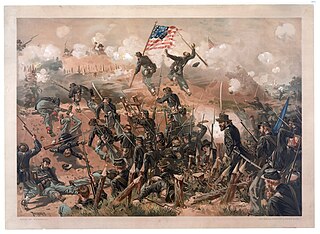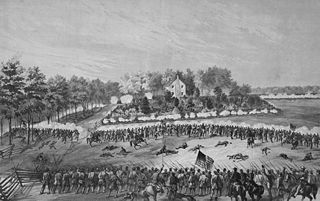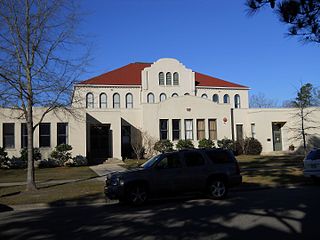
The siege of Vicksburg was the final major military action in the Vicksburg campaign of the American Civil War. In a series of maneuvers, Union Maj. Gen. Ulysses S. Grant and his Army of the Tennessee crossed the Mississippi River and drove the Confederate Army of Mississippi, led by Lt. Gen. John C. Pemberton, into the defensive lines surrounding the fortress city of Vicksburg, Mississippi.

The Arkansas Post, formally the Arkansas Post National Memorial, was the first European settlement in the Mississippi Alluvial Plain and present-day U.S. state of Arkansas. In 1686, Henri de Tonti established it on behalf of Louis XIV of France for the purpose of trading with the Quapaw Nation. The French, Spanish, and Americans, who acquired the territory in 1803 with the Louisiana Purchase, considered the site of strategic value. It was the capital of Arkansas from 1819 until 1821 when the territorial government relocated to Little Rock.

The Vicksburg campaign was a series of maneuvers and battles in the Western Theater of the American Civil War directed against Vicksburg, Mississippi, a fortress city that dominated the last Confederate-controlled section of the Mississippi River. The Union Army of the Tennessee under Major General Ulysses S. Grant gained control of the river by capturing this stronghold and defeating Lieutenant General John C. Pemberton's forces stationed there.

John Clifford Pemberton was a career United States Army officer who fought in the Seminole Wars and with distinction during the Mexican–American War. He resigned his commission to serve as a Confederate lieutenant-general during the American Civil War. He led the Army of Mississippi from December 1862 to July 1863 and was the commanding officer during the Confederate surrender at the Siege of Vicksburg.

The Battle of Jackson was fought on May 14, 1863, in Jackson, Mississippi, as part of the Vicksburg campaign during the American Civil War. After entering the state of Mississippi in late April 1863, Major General Ulysses S. Grant of the Union Army moved his force inland to strike at the strategic Mississippi River town of Vicksburg, Mississippi. The Battle of Raymond, which was fought on May 12, convinced Grant that General Joseph E. Johnston's Confederate army was too strong to be safely bypassed, so he sent two corps, under Major Generals James B. McPherson and William T. Sherman, to capture Johnston's position at Jackson. Johnston did not believe the city was defensible and began withdrawing. Brigadier General John Gregg was tasked with commanding the Confederate rear guard, which fought Sherman's and McPherson's men at Jackson on May 14 before withdrawing. After taking the city, Union troops destroyed economic and military infrastructure and also plundered civilians' homes. Grant then moved against Vicksburg, which he placed under siege on May 18 and captured on July 4. Despite being reinforced, Johnston made only a weak effort to save the Vicksburg garrison, and was driven out of Jackson a second time in mid-July.

The Battle of Champion Hill of May 16, 1863, was the pivotal battle in the Vicksburg Campaign of the American Civil War (1861–1865). Union Army commander Maj. Gen. Ulysses S. Grant and the Army of the Tennessee pursued the retreating Confederate States Army under Lt. Gen. John C. Pemberton and defeated it twenty miles to the east of Vicksburg, Mississippi, leading inevitably to the siege of Vicksburg and surrender. The battle is also known as Baker's Creek.

The Battle of Big Black River Bridge was fought on May 17, 1863, as part of the Vicksburg Campaign of the American Civil War. After a Union army commanded by Major General Ulysses S. Grant defeated Lieutenant General John C. Pemberton's Confederate army at the Battle of Champion Hill on May 16, Pemberton ordered Brigadier General John S. Bowen to hold a rear guard at the crossing of the Big Black River to buy time for the Confederate army to regroup. Union troops commanded by Major General John McClernand pursued the Confederates, and encountered Bowen's rear guard. A Union charge quickly broke the Confederate position, and during the retreat and river crossing, a rout ensued.

The Battle of Raymond was fought on May 12, 1863, near Raymond, Mississippi, during the Vicksburg campaign of the American Civil War. Initial Union attempts to capture the strategically important Mississippi River city of Vicksburg failed. Beginning in late April 1863, Union Major General Ulysses S. Grant led another try. After crossing the river into Mississippi and winning the Battle of Port Gibson, Grant began moving east, intending to turn back west and attack Vicksburg. A portion of Grant's army consisting of Major General James B. McPherson's 10,000 to 12,000-man XVII Corps moved northeast towards Raymond. The Confederate commander of Vicksburg, Lieutenant General John C. Pemberton, ordered Brigadier General John Gregg and his 3,000 to 4,000-strong brigade from Jackson to Raymond.

McRaven was built c. 1797 by Andrew Glass in a town called Walnut Hills, which is now Vicksburg, Mississippi. In the Civil War era, it was known as the Bobb House, and it is listed on the National Register of Historic Places as such. McRaven got its current name from the street it is located on, which was formerly called McRaven Street, but is now Harrison Street. McRaven has been on the Mississippi Department of Archives and History's Historic Preservation list since January 8, 1978. It is also believed by many to be haunted, and has been called "the most haunted house in Mississippi."

One Hanover is a commercial building at 1 Hanover Square, on the southwestern edge of the square, in the Financial District of Lower Manhattan in New York City. It was the site of the United States' first cotton futures exchange, the New York Cotton Exchange.

The Franklin and Armfield Office, which houses the Freedom House Museum, is a historic commercial building in Alexandria, Virginia. Built c. 1810–1820, it was first used as a private residence before being converted to the offices of the largest slave trading firm in the United States, started in 1828 by Isaac Franklin and John Armfield. "As many as [a] million people are thought to have passed through between 1828 and 1861, on their way to bondage in Mississippi and Louisiana". Another source, using ship manifests in the National Archives, gives the number as "at least 5,000".

The Old Courthouse, Warren County, also known as Warren County Courthouse, stands prominently on a hill in Vicksburg, Mississippi, and was a symbol of Confederate resistance during the Siege of Vicksburg. It was designated a National Historic Landmark in 1968 and a Mississippi Landmark in 1986. The landmarked area comprises the entire Courthouse Square, which includes the courthouse and four attached buildings that were originally cistern houses for catching rainwater to fight fires, but these were later converted into offices.

Rosalie Mansion is a historic pre-Civil War mansion and historic house museum in Natchez, Mississippi. Built in 1823, it served as the architectural inspiration for a large number of Natchez's grand Greek Revival mansions, and was a major influence on Antebellum architecture in the greater region. During the American Civil War, it served as Union headquarters for the Natchez area from July 1863 on. It was designated a National Historic Landmark in 1989.
The Port Gibson Battlefield is the site near Port Gibson, Mississippi where the 1863 Battle of Port Gibson was fought during the American Civil War. The battlefield covers about 3,400 acres (1,400 ha) of land west of the city, astride Rodney Road, where Union Army forces were establishing a beachhead after crossing the Mississippi River in a bid to take the Confederate fortress of Vicksburg. The Union victory secured that beachhead and paved the way for the eventual fall of Vicksburg. A 2,080-acre (840 ha) area surrounding part of the site was listed on the National Register of Historic Places in 1972, and a larger area was designated a National Historic Landmark in 2005. In 2009, the battlefield was designated by the Civil War Preservation Trust as one of its Top 10 most endangered Civil War battlefields. In 2011, the Civil War Preservation Trust was renamed the Civil War Trust, which in 2018 became a division of the American Battlefield Trust. The Trust and its partners have acquired and preserved 644 acres (2.61 km2) of the Port Gibson battlefield.
A Mississippi Landmark is a building officially nominated by the Mississippi Department of Archives and History and approved by each county's chancery clerk. The Mississippi Landmark designation is the highest form of recognition bestowed on properties by the state of Mississippi, and designated properties are protected from changes that may alter the property's historic character. Currently there are 890 designated landmarks in the state. Mississippi Landmarks are spread out between eighty-one of Mississippi's eighty-two counties; only Issaquena County has no such landmarks.

The Sidney H. Horner House was built in 1881 by Michael Brennam, an early builder/architect, approximately six blocks to the west of the Mississippi River in Helena, Arkansas. Sidney H. Horner, a member of an early Helena family, was part of a banking firm established by his father, John Sidney Horner. The Italianate style house is made of hand-molded brick. The home has 7 fireplaces and oak parquet floors. The initial footprint of the house was expanded in 1895 with a two-story east wing also made of brick. At the same time, the original small front porch was expanded to run the entire length of the new east addition. Electric lights were also added at about this time.

Balfour House is an antebellum mansion located at the corner of Crawford Street and Cherry Street in Vicksburg, Mississippi. Built in 1835, it was the home of Emma Balfour, celebrated diarist of the Siege of Vicksburg. The red-brick, two-story structure features elements of Greek Revival and Federalist styles and is listed on the National Register of Historic Places.

Ashton Villa is a fully restored, historic home located on the corner of 24th and Broadway in Galveston, Texas, United States. Constructed in 1859, it was one of the first brick structures in Texas built by slaves.

Walthall School, also known as Court Street School, is located at 601 Court Street in Hattiesburg, Mississippi. It was utilized as a public school building from 1902 until 1987. The building is a contributing property to the Hattiesburg Historic Neighborhood District, which was placed on the National Register of Historic Places in 1980. The building was designated a Mississippi Landmark in 1988.





















